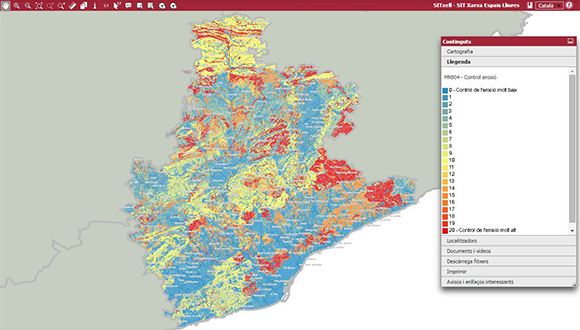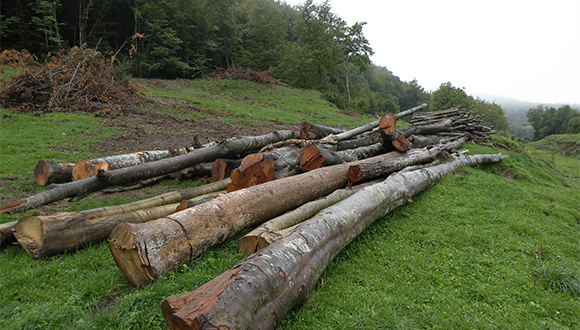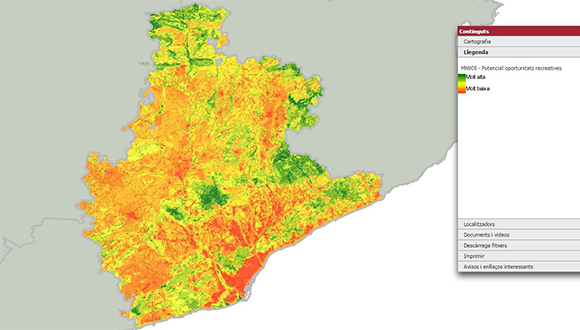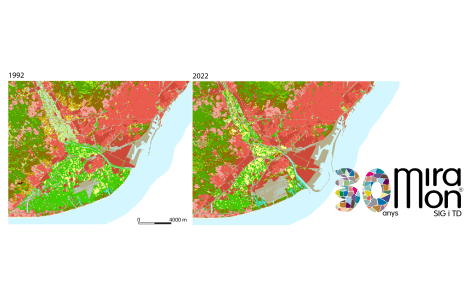The ecosystem services of the province of Barcelona can now be seen with digital maps

The creation of cartography for ecosystem services represents a new tool for territorial analysis and planning. As of very recently the province of Barcelona now has a particularly extensive and detailed mapping of ecosystem services at its disposal. It is hoped that this will be extended to all of Catalonia.

CREAF, the Institute of Environmental Science and Technologies (ICTA) and the City of Barcelona have recently made public a mapping of ecosystem services for the province of Barcelona. The new product is composed of a number of digital maps which together demonstrate the value of a number of particularly important ecosystem services. Thanks to these maps it will be possible to determine with unprecedented precision what areas of the territory may offer more or less services. It is also possible to identify specific benefits provided to the population, including water regulation, provision of food and wood, or sequestration of atmospheric CO2: in other words, services which support people’s health, quality of life, and the economy.
Joan Pino, who together with Corina Basnou coordinates the project from CREAF, states that the objective is that this information “helps cities and other local administrations to plan and manage the territory” by using tools such as Urban Organization Plans (Catalan acronym is POUMs). In the case of the province of Barcelona, it is hoped that this will further the development of a model of a green infrastructure network consisting of open spaces combining biodiversity protection and the provision of ecosystem services to the population. In fact, work on this emerging concept is already underway in the EU project GreenInfraNet.
One of the strengths of this cartographic project has been to combine information about a diverse array of ecosystem services at a high level of detail in a homogenous manner for the whole province of Barcelona. The high resolution of the maps is notable: for each pixel, equivalent to the size of a football field (100 x 100 meters), there is a value stored for a given ecosystem service.

A two-year project which is still underway
This project is the product of three main actors: it was financed by the Office for Territorial Planning and Analysis of the City of Barcelona and has been carried out by CREAF and ICTA. Also assisting the project is the Forest Technology Centre of Catalonia (CTFC), the Catalan Institute of Ornithology and the Unió de Pagesos (farmers union). The initiative has been underway since 2014, resulting in the publication of the cartographic products which are now available via SITxell.
“Though it might be stated with certain reservations, there has been a sort of a paradigm shift in how the territory is seen. While before the classical viewpoint focused on biodiversity, we have now moved on to another based on ecosystem services,” says Joan Pino. For this reason, ecosystem services are receiving more attention in political and scientific debate, and there are already policies in place aimed at the provision of goods and services to society. It is for these reasons that the decision was made to work on the topic by producing the cartography.
One of the strengths of this cartographic project has been to combine information about a diverse array of ecosystem services at a high level of detail in a homogenous manner for the whole province of Barcelona.
Since the information is still very new the data is still being analyzed and interpreted. The next steps are to “review, improve, and expand the current coverage of ecosystem service indicators and carry out a first diagnostic of the distribution of these services throughout the territory,” says Joan Pino. He adds, “this will allow the proposal and development of a first model for green infrastructure in the province of Barcelona.”
In collaboration with the Department of Territory and Sustainability, CREAF aims to expand this type of mapping throughout Catalonia and improve it by adding new indicators providing greater robustness in the analysis of ecosystem services. Moving forward with the project is seen as necessary since it has a clear utility in the public debate on territorial planning and management at different scales.

What is green infrastructure?
Green infrastructure is an emerging concept linked to open space planning in political sphere, and its implementation is done casting a wider net than previous approaches that have typically centered on the conservation of biodiversity. The objective is the conservation and planning of open spaces, strengthening the cohesion and resilience of ecosystems and at the same time contributing to climate change adaptation and reduction of natural disaster vulnerability. The concept of green infrastructure also contributes to a sustainable economy by maintaining ecosystem services and mitigating adverse effects from transportation, energy infrastructures, and economic development in general.
The concept of green infrastructure was presented in the White Book of the European Commission on Adaptation to Climate Change (2009) which established that green infrastructure is “essential for mitigating land use fragmentation and unsustainable land use both within and without Natura 2000 areas, and for addressing the necessity for preserving and restoring ecosystem services and their many benefits.” According to this new concept, the traditional objectives of nature conservation are achieved in close harmony with other objectives quite relevant for citizens, including the maintenance of many different kinds of ecosystem services.
You can learn more about ecosystem services here.
Noticias relacionadas

El IPBES publica dos informes para transformar la forma en que nos relacionamos con la naturaleza, conservarla y sobrevivir

El impacto social de la investigación se consolida en la cultura científica del CREAF


